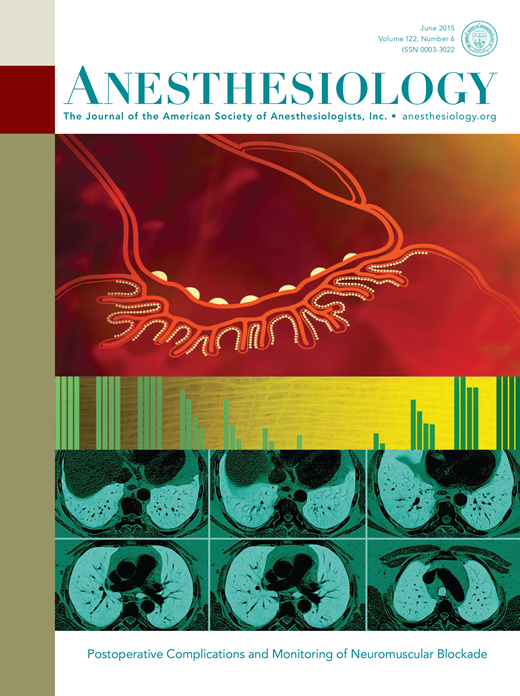术中氯胺酮治疗乳腺癌术后急性疼痛的随机对照试验:疼痛基线时间累积的调节作用。
IF 9.1
1区 医学
Q1 ANESTHESIOLOGY
引用次数: 0
摘要
背景:外科创伤引起的伤害性通路的激活可诱发中枢致敏,这与更大的疼痛严重程度和持续性有关。nmda受体拮抗剂氯胺酮阻断中枢致敏,但在预防术后疼痛方面有不同的记录。患者层面的因素有助于疼痛的可变性,并可能作为预防效果差异效果的标志。方法本前瞻性、纵向随机对照试验探讨术中给予氯胺酮减轻乳房术后疼痛的效果。在手术前,患者报告人口统计和医疗信息,并完成有效的疼痛和心理社会问卷。一部分患者还接受了定量感觉测试,以评估疼痛的基线时间累积(中枢致敏倾向)。协方差分析,控制相关术前和围手术期因素,检查治疗组(氯胺酮与生理盐水)术后2周疼痛结局的差异。探索性调节分析探讨氯胺酮的疗效是否因患者的基线疼痛时间累积而有所不同。结果225例患者中,113例服用氯胺酮,112例服用安慰剂。大多数患者接受乳房肿瘤切除术(53%),16%的患者接受乳房切除术,30%的患者接受乳房切除术并重建。手术后两周的疼痛严重程度或影响没有明显的治疗组差异。然而,适度分析显示,在疼痛基线时间累积较高的患者中,氯胺酮与较低的疼痛严重程度和影响评分相关。结论:通过各种疼痛评估,在术后急性期,与安慰剂相比,氯胺酮与镇痛益处无关。然而,探索性适度分析表明,有证据表明基线时中枢致敏性更大的患者可能获得氯胺酮的镇痛效果。这些发现支持未来收集与试验相关机制相关的基线表型患者特征,以确定哪些患者可能从镇痛干预中获得更大的益处。本文章由计算机程序翻译,如有差异,请以英文原文为准。
A Randomized Controlled Trial of Intraoperative Ketamine for Acute Postsurgical Pain after Breast Cancer Surgery: The Moderating Effect of Baseline Temporal Summation of Pain.
BACKGROUND
Activation of nociceptive pathways by surgical trauma can induce central sensitization, which is associated with greater pain severity and persistence. The NMDA-receptor antagonist ketamine blocks central sensitization, but has a variable track-record for preventing postsurgical pain. Patient-level factors contribute to variability in pain and may serve as markers of differential efficacy of preventive effect.
METHODS
This prospective, longitudinal randomized controlled trial investigated the effectiveness of intraoperatively administered ketamine to decrease postoperative pain after breast surgery. Before surgery, patients reported demographic and medical information and completed validated pain and psychosocial questionnaires. A subset of patients also underwent quantitative sensory testing to assess baseline temporal summation of pain (central sensitization tendency). Analyses of Covariance, controlling for relevant pre- and peri-operative factors, examined treatment group (ketamine vs. saline) differences in 2-week postoperative pain outcomes. Exploratory moderation analysis explored whether the efficacy of ketamine differed based on patients' baseline temporal summation of pain.
RESULTS
Of the sample of 225 patients, 113 received ketamine and 112 received placebo. The majority of patients underwent lumpectomy (53%), with 16% undergoing mastectomy and 30% mastectomy with reconstruction. There were no significant treatment group differences in pain severity or impact reported two weeks after surgery. However, moderation analysis revealed that among patients with higher baseline temporal summation of pain, ketamine was associated with lower pain severity and impact scores.
CONCLUSIONS
Ketamine was not associated with an analgesic benefit over placebo in the acute postoperative period, as measured using a variety of pain assessments. However, exploratory moderation analysis suggested that patients with evidence of a greater central sensitization at baseline may derive an analgesic effect of ketamine. These findings support future collection of baseline phenotypic patient characteristics related to relevant mechanisms in trials, to identify which patients may derive a larger benefit from analgesic interventions.
求助全文
通过发布文献求助,成功后即可免费获取论文全文。
去求助
来源期刊

Anesthesiology
医学-麻醉学
CiteScore
10.40
自引率
5.70%
发文量
542
审稿时长
3-6 weeks
期刊介绍:
With its establishment in 1940, Anesthesiology has emerged as a prominent leader in the field of anesthesiology, encompassing perioperative, critical care, and pain medicine. As the esteemed journal of the American Society of Anesthesiologists, Anesthesiology operates independently with full editorial freedom. Its distinguished Editorial Board, comprising renowned professionals from across the globe, drives the advancement of the specialty by presenting innovative research through immediate open access to select articles and granting free access to all published articles after a six-month period. Furthermore, Anesthesiology actively promotes groundbreaking studies through an influential press release program. The journal's unwavering commitment lies in the dissemination of exemplary work that enhances clinical practice and revolutionizes the practice of medicine within our discipline.
 求助内容:
求助内容: 应助结果提醒方式:
应助结果提醒方式:


